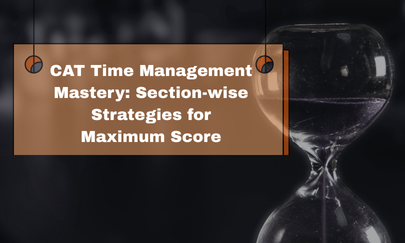
The Common Admission Test (CAT) is one of the most competitive exams in India, serving as the gateway to prestigious business schools like the Indian Institutes of Management (IIMs). With a challenging syllabus and high competition, understanding the intricacies of scoring, particularly negative marking, becomes essential for success. In this blog, we will explore how negative marking affects your CAT percentile and strategies to avoid losing valuable marks.
What is Negative Marking in CAT?
The CAT exam follows a specific marking scheme where incorrect answers lead to a deduction of marks. For every wrong answer in the multiple-choice questions (MCQs), 1 mark is deducted from your total score. However, there is no negative marking for non-MCQ or TITA (Type In The Answer) questions, providing a safer scoring zone for candidates.
Here's the typical CAT marking structure:
- Correct Answer: +3 marks
- Incorrect Answer (MCQ): -1 mark
- Unanswered Question: 0 marks
How Negative Marking Influences Your CAT Score?
Negative marking plays a crucial role in determining your final CAT score, which directly impacts your percentile. The CAT percentile is a relative ranking that reflects your performance compared to other test-takers. The more negative marks you accumulate, the lower your total score, leading to a significant drop in your percentile.
For example:
If a candidate answers 30 questions correctly but also has 10 incorrect answers, they will lose 10 marks due to negative marking. This deduction could pull them down by several percentile points, especially if they are close to a score cut-off.
On the other hand, a candidate with the same number of correct answers but fewer incorrect responses will have a higher score and percentile.
The Psychological Impact of Negative Marking
Negative marking doesn't just impact your score mathematically—it also has psychological effects during the exam. Knowing that every wrong answer will deduct marks can make candidates anxious, leading to second-guessing and overcautious behavior. Some students may even leave questions they could have answered correctly, fearing negative marks, thus missing out on potential points.
However, excessive worry about negative marking can also be detrimental. Striking a balance between being cautious and confident is key to maximizing your score.
Strategies to Minimize Negative Marking
- Selective Answering: Don't attempt every question. Only answer those questions you are reasonably confident about. Guessing blindly will likely result in more negative marks.
- Practice Mock Tests: Take as many mock tests as possible to get familiar with the types of questions and the pressure of time. This will help you gauge when to answer and when to skip.
- Time Management: Proper time management allows you to devote sufficient time to the questions you're confident about, reducing the urge to guess under pressure.
- Avoid Overthinking: Don’t overanalyze simple questions. Many students lose marks by changing their answers multiple times. Trust your instincts, especially in well-practiced areas.
- Identify Your Strong Areas: Focus on sections where you're strong and confident, as you're less likely to make errors in these areas. For weaker sections, adopt a cautious approach.
Negative marking in the CAT exam can significantly impact your overall score and percentile. While it discourages random guessing, it also demands a strategic approach to answering questions. Proper preparation, selective answering, and smart time management are key to minimizing negative marks and boosting your percentile. By adopting a calculated approach, you can navigate the challenge of negative marking and improve your chances of success in the CAT exam.
Any question in your mind?
Connect to our counsellor: 8826807515












